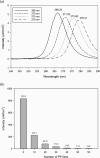Using UVC Light-Emitting Diodes at Wavelengths of 266 to 279 Nanometers To Inactivate Foodborne Pathogens and Pasteurize Sliced Cheese
- PMID: 26386061
- PMCID: PMC4702654
- DOI: 10.1128/AEM.02092-15
Using UVC Light-Emitting Diodes at Wavelengths of 266 to 279 Nanometers To Inactivate Foodborne Pathogens and Pasteurize Sliced Cheese
Abstract
UVC light is a widely used sterilization technology. However, UV lamps have several limitations, including low activity at refrigeration temperatures, a long warm-up time, and risk of mercury exposure. UV-type lamps only emit light at 254 nm, so as an alternative, UV light-emitting diodes (UV-LEDs) which can produce the desired wavelengths have been developed. In this study, we validated the inactivation efficacy of UV-LEDs by wavelength and compared the results to those of conventional UV lamps. Selective media inoculated with Escherichia coli O157:H7, Salmonella enterica serovar Typhimurium, and Listeria monocytogenes were irradiated using UV-LEDs at 266, 270, 275, and 279 nm in the UVC spectrum at 0.1, 0.2, 0.5, and 0.7 mJ/cm(2), respectively. The radiation intensity of the UV-LEDs was about 4 μW/cm(2), and UV lamps were covered with polypropylene films to adjust the light intensity similar to those of UV-LEDs. In addition, we applied UV-LED to sliced cheese at doses of 1, 2, and 3 mJ/cm(2). Our results showed that inactivation rates after UV-LED treatment were significantly different (P < 0.05) from those of UV lamps at a similar intensity. On microbiological media, UV-LED treatments at 266 and 270 nm showed significantly different (P < 0.05) inactivation effects than other wavelength modules. For sliced cheeses, 4- to 5-log reductions occurred after treatment at 3 mJ/cm(2) for all three pathogens, with negligible generation of injured cells.
Copyright © 2015, American Society for Microbiology. All Rights Reserved.
Figures


Similar articles
-
Fundamental Characteristics of Deep-UV Light-Emitting Diodes and Their Application To Control Foodborne Pathogens.Appl Environ Microbiol. 2015 Jul 10;82(1):2-10. doi: 10.1128/AEM.01186-15. Print 2016 Jan 1. Appl Environ Microbiol. 2015. PMID: 26162872 Free PMC article.
-
Inactivation of Nonpathogenic Escherichia coli, Escherichia coli O157:H7, Salmonella enterica Typhimurium, and Listeria monocytogenes in Ice Using a UVC Light-Emitting Diode.J Food Prot. 2017 Jul;80(7):1198-1203. doi: 10.4315/0362-028X.JFP-17-036. J Food Prot. 2017. PMID: 28621585
-
Elevated Inactivation Efficacy of a Pulsed UVC Light-Emitting Diode System for Foodborne Pathogens on Selective Media and Food Surfaces.Appl Environ Microbiol. 2018 Oct 1;84(20):e01340-18. doi: 10.1128/AEM.01340-18. Print 2018 Oct 15. Appl Environ Microbiol. 2018. PMID: 30097449 Free PMC article.
-
Recent advances on the application of UV-LED technology for microbial inactivation: Progress and mechanism.Compr Rev Food Sci Food Saf. 2020 Nov;19(6):3501-3527. doi: 10.1111/1541-4337.12645. Epub 2020 Oct 11. Compr Rev Food Sci Food Saf. 2020. PMID: 33337035 Review.
-
A Comprehensive Analysis of the UVC LEDs' Applications and Decontamination Capability.Materials (Basel). 2022 Apr 13;15(8):2854. doi: 10.3390/ma15082854. Materials (Basel). 2022. PMID: 35454546 Free PMC article. Review.
Cited by
-
Rapid inactivation of SARS-CoV-2 with deep-UV LED irradiation.Emerg Microbes Infect. 2020 Dec;9(1):1744-1747. doi: 10.1080/22221751.2020.1796529. Emerg Microbes Infect. 2020. PMID: 32673522 Free PMC article.
-
Effects of Combined Aerosolization with Ultraviolet C Light-Emitting Diode on Enterohemorrhagic Escherichia coli and Staphylococcus aureus Attached to Soft Fresh Produce.Foods. 2021 Aug 8;10(8):1834. doi: 10.3390/foods10081834. Foods. 2021. PMID: 34441611 Free PMC article.
-
Comparative assessment of UV-C radiation and non-thermal plasma for inactivation of foodborne fungal spores suspension in vitro.RSC Adv. 2024 May 23;14(24):16835-16845. doi: 10.1039/d4ra01689k. eCollection 2024 May 22. RSC Adv. 2024. PMID: 38784412 Free PMC article.
-
Inactivation of Escherichia Coli and Salmonella Using 365 and 395 nm High Intensity Pulsed Light Emitting Diodes.Foods. 2019 Dec 13;8(12):679. doi: 10.3390/foods8120679. Foods. 2019. PMID: 31847186 Free PMC article.
-
Stability of SARS-CoV-2 in cold-chain transportation environments and the efficacy of disinfection measures.Front Cell Infect Microbiol. 2023 Apr 19;13:1170505. doi: 10.3389/fcimb.2023.1170505. eCollection 2023. Front Cell Infect Microbiol. 2023. PMID: 37153150 Free PMC article.
References
-
- Guerrero-Beltrán JA, Barbosa-Cánovas GV. 2004. Review: advantages and limitations on processing foods by UV light. Food Sci Technol Int 10:137–147. doi:10.1177/1082013204044359. - DOI
-
- Dumé B. 2006. LEDs move into the ultraviolet. Physics World, Bristol, United Kingdom: http://physicsworld.com/cws/article/news/2006/may/17/leds-move-into-the-....
-
- Kalisvaart BF. 2004. Re-use of wastewater: preventing the recovery of pathogens by using medium-pressure UV lamp technology. Water Sci Technol 50:337–344. - PubMed
Publication types
MeSH terms
LinkOut - more resources
Full Text Sources
Other Literature Sources
Molecular Biology Databases

